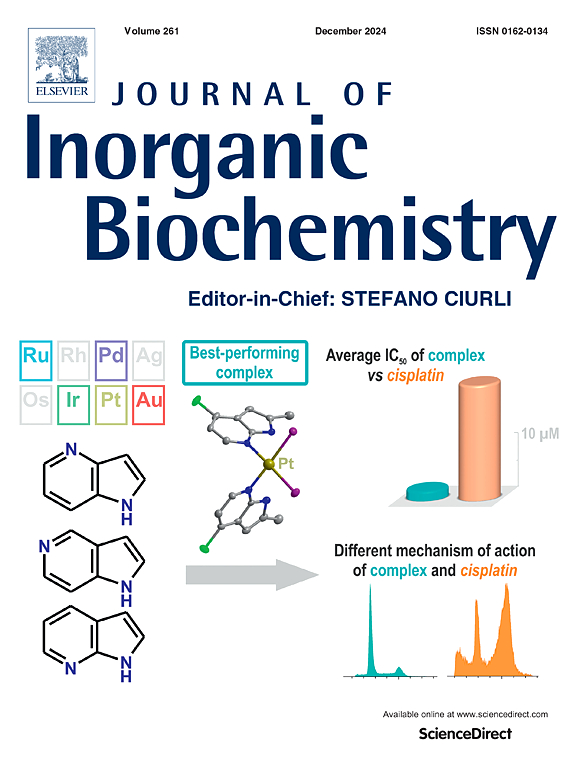配体酯化对钌(II)/dppb吡啶二羧酸配合物对乳腺癌细胞毒性的影响
IF 3.2
2区 化学
Q2 BIOCHEMISTRY & MOLECULAR BIOLOGY
引用次数: 0
摘要
本文报道了五种新的钌(II)配合物的合成和表征,其通式为[Ru(NO) 2 (dppb)],其中dppb为1,4-二(二苯基膦)丁烷,NO配体是吡啶羧酸的衍生物:吡啶酸(C20), 2,3- (C23), 2,4- (C24)和2,5-吡啶二羧酸(C25),以及2,4-吡啶二羧酸(C24e)的单酯衍生物,通过Fischer酯化得到。通过元素分析、摩尔电导率、循环伏安法、核磁共振(1H和31P{1H})和单晶x射线衍射(C23和C24)对配合物进行了表征。通过DMSO中的紫外可见光谱和DMSO/DMEM混合物(C24)中的31P{1H} NMR证实了配合物在溶液中的稳定性,没有明显的物种形成反应的证据。生物学实验显示,复合物C20和C24e对人乳腺癌细胞系(MCF-7和MDA-MB-231)的细胞毒活性和选择性优于非致瘤性HaCaT细胞。值得注意的是,C20在MCF-7细胞的三维球体模型中保持活性,显示出比顺铂更强的效力。此外,C20和C24e都不会诱导诱变作用或产生细胞内活性氧,提示细胞毒性的其他机制。这些发现支持吡啶和酯化吡啶二羧酸钌(II)配合物作为有前途的抗肿瘤药物的潜力。本文章由计算机程序翻译,如有差异,请以英文原文为准。

Impact of ligand esterification on the cytotoxicity against breast cancer cells of ruthenium(II)/dppb pyridinedicarboxylate complexes
Here we report the synthesis and characterization of five new ruthenium(II) complexes with the general formula [Ru(N![]() O)₂(dppb)], where dppb is 1,4-bis(diphenylphosphino)butane and the N
O)₂(dppb)], where dppb is 1,4-bis(diphenylphosphino)butane and the N![]() O ligands are derivatives of pyridinecarboxylic acids: picolinic acid (C20), 2,3- (C23), 2,4- (C24), and 2,5-pyridinedicarboxylic acids (C25), as well as the monoester derivative of 2,4-pyridinedicarboxylic acid (C24e), obtained by Fischer esterification. The complexes were characterized by elemental analysis, molar conductivity, cyclic voltammetry, NMR spectroscopy (1H and 31P{1H}), and single-crystal X-ray diffraction (for C23 and C24). The stability of the complexes in solution was confirmed by UV–Vis spectroscopy in DMSO and by 31P{1H} NMR in a DMSO/DMEM mixture (for C24), with no evidence of significant speciation reactions. Biological assays revealed that complexes C20 and C24e exhibit significant cytotoxic activity and selectivity against human breast cancer cell lines (MCF-7 and MDA-MB-231) over non-tumorigenic HaCaT cells. Notably, C20 remained active in three-dimensional spheroid models of MCF-7 cells, showing greater potency than cisplatin. Additionally, both C20 and C24e did not induce mutagenic effects or generate intracellular reactive oxygen species, suggesting alternative mechanisms of cytotoxicity. These findings support the potential of picolinic and esterified pyridinedicarboxylic acid ruthenium(II) complexes as promising antitumor agents.
O ligands are derivatives of pyridinecarboxylic acids: picolinic acid (C20), 2,3- (C23), 2,4- (C24), and 2,5-pyridinedicarboxylic acids (C25), as well as the monoester derivative of 2,4-pyridinedicarboxylic acid (C24e), obtained by Fischer esterification. The complexes were characterized by elemental analysis, molar conductivity, cyclic voltammetry, NMR spectroscopy (1H and 31P{1H}), and single-crystal X-ray diffraction (for C23 and C24). The stability of the complexes in solution was confirmed by UV–Vis spectroscopy in DMSO and by 31P{1H} NMR in a DMSO/DMEM mixture (for C24), with no evidence of significant speciation reactions. Biological assays revealed that complexes C20 and C24e exhibit significant cytotoxic activity and selectivity against human breast cancer cell lines (MCF-7 and MDA-MB-231) over non-tumorigenic HaCaT cells. Notably, C20 remained active in three-dimensional spheroid models of MCF-7 cells, showing greater potency than cisplatin. Additionally, both C20 and C24e did not induce mutagenic effects or generate intracellular reactive oxygen species, suggesting alternative mechanisms of cytotoxicity. These findings support the potential of picolinic and esterified pyridinedicarboxylic acid ruthenium(II) complexes as promising antitumor agents.
求助全文
通过发布文献求助,成功后即可免费获取论文全文。
去求助
来源期刊

Journal of Inorganic Biochemistry
生物-生化与分子生物学
CiteScore
7.00
自引率
10.30%
发文量
336
审稿时长
41 days
期刊介绍:
The Journal of Inorganic Biochemistry is an established international forum for research in all aspects of Biological Inorganic Chemistry. Original papers of a high scientific level are published in the form of Articles (full length papers), Short Communications, Focused Reviews and Bioinorganic Methods. Topics include: the chemistry, structure and function of metalloenzymes; the interaction of inorganic ions and molecules with proteins and nucleic acids; the synthesis and properties of coordination complexes of biological interest including both structural and functional model systems; the function of metal- containing systems in the regulation of gene expression; the role of metals in medicine; the application of spectroscopic methods to determine the structure of metallobiomolecules; the preparation and characterization of metal-based biomaterials; and related systems. The emphasis of the Journal is on the structure and mechanism of action of metallobiomolecules.
 求助内容:
求助内容: 应助结果提醒方式:
应助结果提醒方式:


